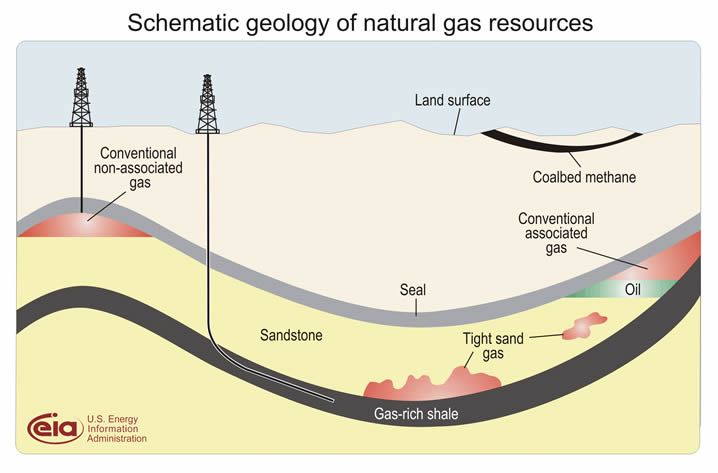The term unconventional evidently first appeared in the 1970s. Starting in the mid-1970s in response to a severe natural gas shortage that was prompted by earlier uncommercial price ceilings, the U.S. Department of Energy (DOE) initiated research into ways to boost natural gas recovery. DOE research targeted what they called “unconventional” sources of natural gas including shale gas, tight gas sands, and coal-bed methane, methane hydrate, and geopressured aquifers. The DOE also started research into uneconomic oil sources including enhanced oil recovery and oil shales.
In 1976, unconventional gas contributed less than seven percent of the 19.95 trillion cubic feet (tcf) produced in the U.S. and the term “unconventional” appropriately referred to their rarity and the need for special technology for their recovery.
Natural gas from unconventional formations now represents more than half of U.S. production. EIA reports that 2014 shale gas production was 13.4 tcf, or about 52 percent of the 25.7 tcf produced in the U.S.
Natural gas from unconventional reservoirs is chemically the same as that from conventional reservoirs. It is primarily methane with modest amounts of heavier hydrocarbons such as propane, plus carbon dioxide and other inert gases.
Geology differentiates conventional from unconventional reservoirs. This figure from the U.S. Energy Information Administration shows the general distinctions between various conventional and unconventional reservoirs.

Geology of Natural Gas Resources Diagram
In general, conventional oil and gas occur in porous and permeable sandstone, limestone and dolomite formations. The buoyant hydrocarbon has migrated from where it was generated (the source rock) and is usually underlain by denser water. It is trapped and kept from rising by an impermeable, sealing formation. The EIA diagram also reflects the fact that gas regularly occurs with oil i.e., associated gas.
Shale gas and tight gas are contained in regionally widespread formations that have low porosity and very low permeability. Natural and induced fractures in a vertical or horizontal well are required for the hydrocarbons to flow to a wellbore at sufficient rates to be commercial. As with all general definitions, there are many exceptions and special cases.
To confuse the discussion by adding another term, the U.S. Geological Survey calls shale oil and gas, tight gas sands and coal-bed methane continuous deposits. That means they are geographically extensive accumulations that generally lack well-defined oil/water or gas/water contacts. Unconventional and continuous natural gas are essentially the same.
Given that reservoirs were called unconventional because they were out of the ordinary, but are now common, it is expected that the term would eventually be abandoned. However, there does not seem to be any push to abandon the word.